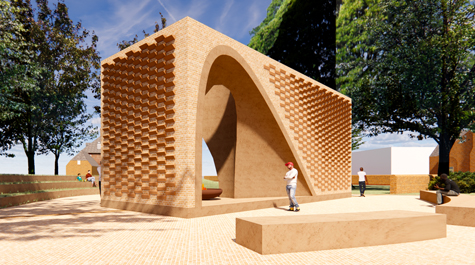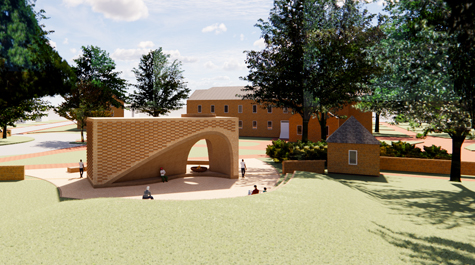Design for W&M’s memorial to the enslaved unveiled
Fundraising target met for $2M project
A finalized design concept for the Memorial to the African Americans Enslaved by William & Mary was presented to the Board of Visitors Tuesday. Fundraising targets for the project have been met, with more than $1 million raised in private gifts, which will be matched by the Board of Visitors. Kjellstrom & Lee will lead construction of the memorial, with work expected to begin in early 2021. When completed, the memorial and surrounding area will reimagine the Jamestown Road pathway to the university’s Historic Campus, positioned just across the street from the Office of Undergraduate Admission.
“The final concept design has the gravitas we sought. It gives dignity and presence to those who were enslaved by William & Mary and whose labor built the university – without romanticizing that painful history,” President Katherine A. Rowe said. “In the process of refining the design, we recognized that the memorial site will reimagine the Jamestown Road entrance to campus. Both symbolically and actually, the first step for many on campus will be through this more forthright telling of our history.”
“Many different members of the community contributed to this idea, from its initial imaginings in 2007. It has been students, faculty, staff, alumni, two presidents, current and former members of the Board, neighbors in town ... The groundbreaking will realize the aspirations of so many.”
The design, created by architectural firm Baskervill, is based on a concept created by William Sendor '11 as part of an international competition the university hosted in 2018 to solicit ideas. The memorial, titled “Hearth,” will resemble a brick fireplace and include the names of people known to have been enslaved by the university. According to the design narrative, the asymmetrical void in the brick memorial “receives the community yet also embodies the emptiness of slavery.” It will be 16 feet wide, 45 feet long and 20 feet high and located on the Historic Campus on the south side of the Wren Building.
“It’s going to be a striking addition to the Historic Campus. As a new pathway into campus, it will be the first structure many visitors encounter during their admission tours” said Chon Glover, chief diversity officer. “The memorial will be a sacred space where we remember and honor the invisible and often unacknowledged labor of the persons enslaved by William & Mary.
“By its mere presence it will ensure that our campus landscape reflects and acknowledges a more inclusive history, which had been invisible for so long, but made visible through the decade of research made possible by the Lemon Project.”
The Board of Visitors launched fundraising for the project with former Rector Jeffrey B. Trammell '73 and every former and current rector contributing to this initial effort.
Fundraising expanded at this year’s One Tribe One Day on June 23. A gift of $250,000 from Goody Tyler, an honorary alumnus, kicked off giving for the memorial that day, with 363 other donors contributing a combined $86,000. Significant gifts from Elaine and Todd Stottlemyer '85; Cliff Fleet '91, M.A. '93, J.D. '95, M.B.A. '95, and Fran Zemmel; and Rob '74 and Jean Estes '75 enabled the university to reach its goal of $1 million in private funds. In total, about 90% of the private funds raised for the memorial were secured between One Tribe One Day and mid-August.
The Board of Visitors will match the private funds raised for the memorial, covering the total cost of the project at $2 million.
“The memorial is so important to an institution so interwoven in American history,” Rector John E. Littel P ’22 said. “We have an obligation to tell the full story of William & Mary and to redress the inequities of our history as best as we are able. I am gratified that the Board of Visitors and the entire William & Mary community recognizes that obligation and offers its unqualified support to this project.”
The project originated from a resolution passed by the Student Assembly during the 2007-2008 academic year that called on the university to research and make public its history with slavery and to establish a memorial to the people who were enslaved, according to Jody Allen, director of the Lemon Project and assistant professor of history.
“This resolution was a powerful step, and I hope that it inspires current Student Assembly senators to move their ideas forward despite not being able to imagine the outcome. They should remember that when Senator Tiseme Zegeye, '08, Richael Faithful '07 and Justin Reid '09, NAACP campus chapter leaders, began this work, they did so not knowing the outcome, but they did it anyway,” said Allen. “Their work led to the establishment of The Lemon Project: A Journey of Reconciliation, the uncovering of a more complete history of this 327-year-old institution, and soon a memorial to those known and unknown African Americans who played a vital role in the establishment and maintenance of the university.
“The women, children and men who toiled here without remuneration for 172 years will not be forgotten again. Indeed, this grand and beautiful addition to the campus will be a constant reminder of their lives and their contribution to this community.”
The Lemon Project laid the foundation for much of the reconciliation work that the university has engaged in with the African-American community throughout the past decade. Established in 2009 by the Board of Visitors, the project has conducted research into W&M’s history, initiated new traditions like the Donning of the Kente ceremony, and hosted myriad classes, symposia and other educational and community-building events.
“The memorial project has been significant since the Lemon Project released its early research and we were able to uncover so much about our history,” said Glover. “The momentum has been building since the board’s resolution in 2009 and the culmination of this structure will be a highlight and lead to further research done by the Lemon Project.
“It’s wonderful that W&M was one of the first schools to begin this work as many other universities have recently begun to investigate their history and ties to slavery. The memorial will be a wonderful addition to our campus landscape as we remember, reflect and honor those whose names we know as well as those names we do not know. I hope the memorial will also be a source of pride for the Williamsburg and surrounding areas.”
In 2018, the Board of Visitors adopted a resolution to extend the Lemon Project and to apologize for the university’s history with slave labor and racial discrimination. Earlier this year, a working group was established to develop principles around naming and renaming of university buildings, spaces and structures. That group recently published a draft of those principles and held a 10-day period for public comment. The principles will go before the Board at its September meeting.
William & Mary was planning its first Juneteenth celebration this year, but it was postponed due to the COVID-19 pandemic. It is expected to proceed next year near the site where the memorial will be constructed, said Glover. Work on the memorial will be temporarily paused for the celebration.
“Juneteenth and the reason for the memorial are so closely related that we want to invite the community in to be a part of this project as it nears the final completion,” said Glover. “Community collaboration has always been at the center of the Lemon Project’s work and the memorial will belong to W&M and the Williamsburg area.”
 Skip to main content
Skip to main content


